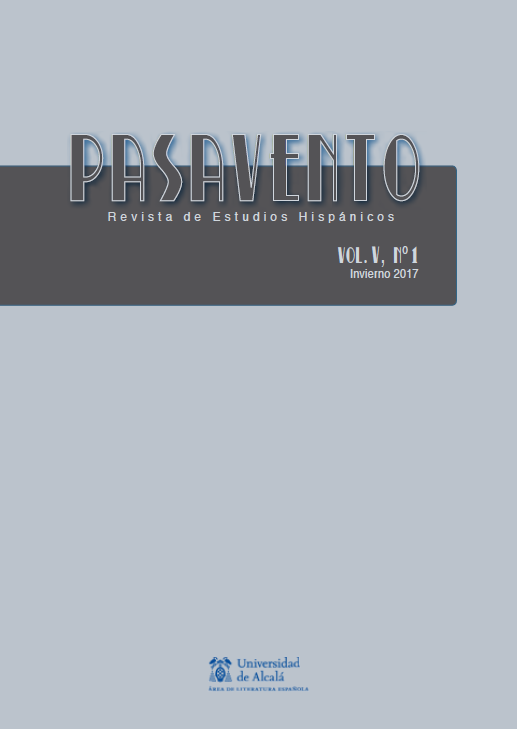María Negroni and the Staging of the Unsaid
DOI:
https://doi.org/10.37536/preh.2017.5.1.866Keywords:
Argentine Literature, Poetry, Intermediality, Reader Role, SubjectivityAbstract
The literary work of María Negroni constantly creates dialogues between genres and media. Focusing on her long poem La jaula bajo el trapo (1991) and her novel La Anunciación (2007), this article aims to analyse how the texts, through the written representation of other media, activate the conative function of language, summoning the reader to take the position of a spectator; that is, to assume the role of the theatre audience when viewing a performance. This reader-audience role will in turn open the possibility of, by a combination of cognitive processes and sensorial perception, getting in touch with those aspects of experience and memory that are never put into words. Through the analysed examples, the article postulates that the texts in question invite to reflect not only on the limitations of language as regards describing experience, but also on the notion of subject and the idea of a unitary subjectivity.
References
Benjamin, Walter (1998): “Sobre el lenguaje en general y sobre el lenguaje de los hombres”. En: Para una crítica de la violencia y otros ensayos. Iluminaciones IV. Trad. Roberto J. Blatt Weinstein. Madrid, Taurus, pp. 59-74.
Bocchino, Adriana (2011): “Escritura como lugar de arraigo en el exilio: Tununa Mercado y María Negroni”, 452˙F: Revista de Teoría de la Literatura y Literatura Comparada, n.º 4, pp. 92-109.
Bortignon, Martina (2013): “El sujeto enunciativo en poesía. Propuesta de un modelo de estudio”, Gramma, vol. XXIV, n.º 51, pp. 40-57.
Braidotti, Rosi (2003): “Becoming Woman: Or Sexual Difference Revisited”, Theory, Culture & Society, vol. 20, n.º 3, pp. 43-64.
Braidotti, Rosi (2005): Metamorfosis. Hacia una teoría materialista del devenir. Trad. Ana Varela Mateos. Madrid, Ediciones Akal.
Castro, Andrea (2015a): “El arte como horizonte utópico del sentir en La Anunciación”, 452ºF: Revista de Teoría de la Literatura y Literatura Comparada, n.º 12, pp. 167-181.
Castro, Andrea (2015b): “Habitando la lengua: subjetividades nómadas en la narrativa de María Negroni”. En: Andrea Castro y Anna Forné (eds.), De nómades y migrantes. Desplazamientos en la literatura, el cine y el arte hispanoamericanos. Rosario, Beatriz Viterbo Editora.
Cavarero, Adriana (2005): For More than One Voice: Toward a Philosophy of Vocal Expression. Stanford, Stanford University Press.
Chion, Michel (1999): The Voice in Cinema. Trad. Claudia Gorbman. Nueva York, Columbia University Press.
Didi-Huberman, Georges (2003): The Power of the Figure: Exegesis and Visuality in Christian Art. Umeå, Dept. of History and Theory of Art.
Didi-Huberman, Georges (2011): Lo que vemos, lo que nos mira. Trad. Horacio Pons. Buenos Aires, Manantial.
Guerrero, Juan Carlos (2010): “Los cuerpos en dolor (I): emblemática del régimen ético de la violencia”, Revista de estudios sociales, n.º 35, pp. 123-37.
Iser, Wolfgang (1980): The Act of Reading: a Theory of Aesthetic Response. Baltimore, Johns Hopkins University Press.
Lispector, Clarice (1982): La pasión según G. H. Trad. s.n. La Habana, Casa de las Américas.
Merleau-Ponty, Maurice (1993): Fenomenología de la percepción. Trad. Jem Cabanes. Barcelona, Planeta-Agostini.
Moreno, María (2015): “María Negroni - La jaula bajo el trapo”. En: Ediciones de la Palma. Accesible en <http://www.edicioneslapalma.com/novedades/193/La-jaula-bajoel-trapo> [última visita: 14.09.2015].
Negroni, María (2007): La Anunciación. Buenos Aires, Seix Barral.
Negroni, María (2009): “La felicidad de un mundo impreciso”, Revista Literaria AZUL@RTE. Accesible en <http://revistaliterariaazularte.blogspot.se/2010/01/maria-negroni-la-felicidad-de-un-mundo.html> [última visita: 24.08.2015].
Negroni, María (2014): La jaula bajo el trapo. Madrid, Ediciones La Palma.
Rancière, Jacques (2010): “El espectador emancipado”. En: El espectador emancipado. Trad. Ariel Dilon. Buenos Aires, Manantial, pp. 9-28.
Scarano, Laura; Romano, Marcela; Ferrari, Marta (1994): La voz diseminada: hacia una teoría del sujeto en la poesía española. Buenos Aires, Editorial Biblos.
Tejeda, Isabel (2002): “Teatro: Tadeusz Kantor - La clase muerta”, Enfocarte.com - Revista digital de arte y cultura. Accesible en http://www.enfocarte.com/3.18/teatro.html [última visita: 15.10.2015].
Thenon, Luis (2013): “La escritura intermedial en la escena actual”, Diálogos. Revista Electrónica de Historia, vol. 14, n.º 2. Accesible en <http://www.redalyc.org/articulo.oa?id=43928825007> [última visita: 15.10.2015].
Downloads
Published
How to Cite
Issue
Section
License
Copyright (c) 2017 Pasavento. Revista de Estudios Hispánicos

This work is licensed under a Creative Commons Attribution 4.0 International License.








